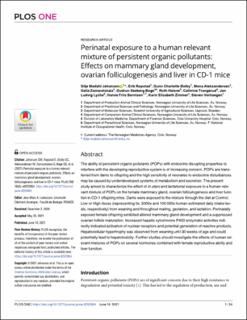| dc.contributor.author | Johanson, Silje Modahl | |
| dc.contributor.author | Ropstad, Erik | |
| dc.contributor.author | Østby, Gunn Charlotte | |
| dc.contributor.author | Aleksandersen, Mona | |
| dc.contributor.author | Zamaratskaia, Galia | |
| dc.contributor.author | Boge, Gudrun Seeberg | |
| dc.contributor.author | Halsne, Ruth | |
| dc.contributor.author | Trangerud, Cathrine | |
| dc.contributor.author | Lyche, Jan Ludvig | |
| dc.contributor.author | Berntsen, Hanne Friis | |
| dc.contributor.author | Zimmer, Karin Elisabeth | |
| dc.contributor.author | Verhaegen, Steven | |
| dc.date.accessioned | 2021-10-01T10:43:43Z | |
| dc.date.available | 2021-10-01T10:43:43Z | |
| dc.date.created | 2021-06-15T10:53:55Z | |
| dc.date.issued | 2021 | |
| dc.identifier.issn | 1932-6203 | |
| dc.identifier.uri | https://hdl.handle.net/11250/2786957 | |
| dc.description.abstract | The ability of persistent organic pollutants (POPs) with endocrine disrupting properties to interfere with the developing reproductive system is of increasing concern. POPs are transferred from dams to offspring and the high sensitivity of neonates to endocrine disturbances may be caused by underdeveloped systems of metabolism and excretion. The present study aimed to characterize the effect of in utero and lactational exposure to a human relevant mixture of POPs on the female mammary gland, ovarian folliculogenesis and liver function in CD-1 offspring mice. Dams were exposed to the mixture through the diet at Control, Low or High doses (representing 0x, 5000x and 100 000x human estimated daily intake levels, respectively) from weaning and throughout mating, gestation, and lactation. Perinatally exposed female offspring exhibited altered mammary gland development and a suppressed ovarian follicle maturation. Increased hepatic cytochrome P450 enzymatic activities indirectly indicated activation of nuclear receptors and potential generation of reactive products. Hepatocellular hypertrophy was observed from weaning until 30 weeks of age and could potentially lead to hepatotoxicity. Further studies should investigate the effects of human relevant mixtures of POPs on several hormones combined with female reproductive ability and liver function. | |
| dc.language.iso | eng | |
| dc.title | Perinatal exposure to a human relevant mixture of persistent organic pollutants: Effects on mammary gland development, ovarian folliculogenesis and liver in CD-1 mice | |
| dc.type | Peer reviewed | |
| dc.type | Journal article | |
| dc.description.version | publishedVersion | |
| dc.source.volume | 16 | |
| dc.source.journal | PLOS ONE | |
| dc.source.issue | 6 | |
| dc.identifier.doi | 10.1371/journal.pone.0252954 | |
| dc.identifier.cristin | 1915853 | |
| dc.relation.project | Norges forskningsråd: 204361 | |
| dc.relation.project | Norges forskningsråd: 21307 | |
| cristin.ispublished | true | |
| cristin.fulltext | original | |
| cristin.qualitycode | 1 | |
